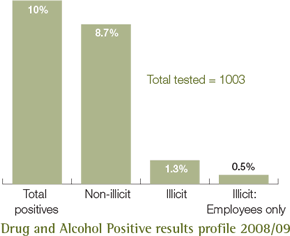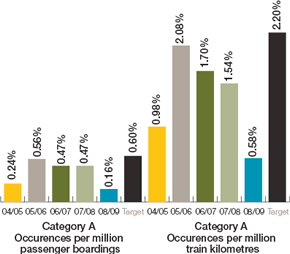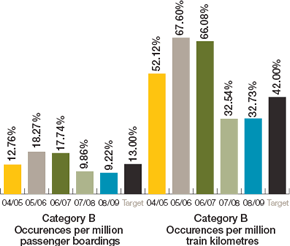Compliance Reports
Health & Safety
The strong focus on safety as a core value of the organisation continued during the year. Representatives of the safety teams from across the PTA held a strategic safety planning day and identified seven key focus areas which formed the Health, Safety and Environment (HSE) Strategic Directions for the year. This document is updated annually and endorsed by the Executive HSE Management Committee to ensure a continued focus on strategic safety management.
Integrated HSE Management System
PTA’s integrated HSE Management System is based on a risk management approach and combines the common elements of occupational and operational (rail) safety, as well as environmental management. Each discipline is mapped to relevant Australian Standards (OSH - AS4801; Rail - AS4292; Environment - AS14001) on an integrated compliance matrix, enabling PTA to retain the ability to separate out the three areas for discipline-specific audits and reviews. PTA’s HSE Management System is regularly monitored and reviewed to ensure that all aspects, from local hazard control measures to the overarching organisational HSE strategy, are working effectively to identify areas for improvement.
Proactive Programs
PTA’s proactive health and safety programs continued throughout the year, including the Safety Topic of the Month campaign and the Safety STAR (Stop Think Assess Respond) hazard management program. HSE committees continued to operate at location, branch, divisional and executive levels across the organisation. Together, these initiatives form part of the organisation’s long-term safety cultural change program.
The HSE Handbook for employees was complemented by the introduction of a supervisor’s edition, specifically aimed at providing practical guidance in HSE management and responsibilities for the PTA’s managers and supervisors. In addition, pamphlet stands were introduced at key locations across the organisation, to provide frontline staff with direct access to the suite of HSE publications issued by the organisation, including HSE handbooks, environmental management and workers’ compensation booklets, and brochures covering such topics as fatigue, bullying, violence and aggression, infectious diseases, and workstation ergonomics.
There were also several health initiatives conducted, including annual free influenza inoculations and a targeted prevention program for swine influenza A (H1N1).
Training
Training in safety and health continued to be a priority, with many managers and supervisors completing a two-day training course on their occupational safety and health responsibilities. A contingent of PTA safety and health representatives, as well as several supervisors, managers and safety coordinators, attended the 2008 WorkSafe forum where they heard from and questioned a panel of safety experts and presenters on various topics.
Regular in-house training programs continued, including half and full-day corporate HSE inductions for administrative and operational staff, and a full-day, interactive training course on how to conduct effective HSE investigations. Training in the management of violence, aggression and bullying, launched in 2007, continued to be rolled out across the organisation. Fatigue management training for supervisors started in June 2008, with training for employees commencing in September 2008. Training in specific hazards, such as confined spaces, was also provided to targeted workers.
The PTA also coordinated a contract management and responsibilities seminar, with the keynote address by international barrister Gerard Forlin, and additional presentations provided by representatives from WorkSafe, the Office of Energy, RiskCover and the PTA. The workshop concluded with a mock coronial inquiry. The 110 attendees included staff from PTA as well as representatives from key contractors, service providers, regulators and other stakeholders. A second workshop is planned for the first half of 2009/10.
Rail Safety Accreditation
The rail safety component of the HSE management system was updated to meet new requirements resulting from national changes to rail safety management. Areas updated included reporting to ONS-1(WA), fatigue management, risk management and safety culture programs.
Compliance audits, inspections and reporting
The annual rail safety compliance audit was conducted by the Office of Rail Safety (ORS) in November 2008, and a report was issued on 4 December 2008. The rail safety audit identified two non-compliances and 24 observations. All issues identified at audit were addressed and closed out by 20 March 2009.
Throughout 2008/09, safety and health representatives in each operating division continued to conduct regular workplace inspections, in accordance with the Occupational Safety and Health Act (1984).
A comprehensive HSE performance report is provided to the PTA’s Executive HSE Management Committee each quarter. The committee meets quarterly to discuss the report and identify strategic HSE actions required as a result of trends and other issues identified in the report. PTA also prepares an annual rail safety performance report for the ORS.
Inquiries and inspections
The ORS requested one (1) Category A incident for investigation under Section 39(3) of the Rail Safety Act (1998). On 12 January 2009, a railcar leaving the Nowergup Depot (travelling at 15kmh) derailed. The main causal factor was loss of traction due to early morning dew, which set the railcar into a slide. Corrective actions included placing Automatic Train Protection (ATP) transponders in the track at Nowergup to reduce the speed to 10kmh and provide more warning to the driver.
Reporting Systems
The PTA’s OSH reporting system, launched on 1 July 2004, enables the organisation to capture reported hazards, near-misses and incidents, and facilitates interrogation of data to analyse trends. An upgrade of the system commenced in June 2009 and will involve ongoing consultation, as well as training for key users, in the coming financial year.
The organisation’s rail safety reporting system enables the organisation to capture incidents and notifiable occurrences specifically related to rail safety and is the conduit for reporting to the rail safety regulator. This system was updated in 2008/09 to meet the new national reporting requirements as defined in ONS-1(WA).
Injury Management
Injury prevention and injury management continue to be a focus for the PTA. The organisation again did not record a fatal incident to a worker on the system. With the exception of PTA security services, PTA exceeded the 10 per cent improvement target for Lost Time Injury Incidence/Disease Rate, with a 12.2 per cent reduction equivalent figure for the previous financial year. With the inclusion of security services staff, this becomes a 32.7 per cent increase.
The increase in injuries to transit officers, the result of increased anti-social behaviour on the rail network, was identified through PTA’s monitoring processes during the year. A project was initiated to analyse the trend and make recommendations for improvement. The recommendation from this trend investigation will be submitted to the PTA’s Executive HSE Committee in early 2009/10 for endorsement and will be implemented accordingly.
Employees who are injured are supported by the PTA’s injury management team, in accordance with the Workers’ Compensation and Injury Management Act (1981). PTA’s injury management system uses the principle of early intervention and includes return-to-work programs developed in accordance with the Act.
|
2007/08 |
2008/09 |
CHANGE |
||
|---|---|---|---|---|
|
LTI Incidence Rate |
PTA (including security services) |
6.12 |
8.12 |
↑ 32.7% |
|
PTA (excluding security services) |
4.59 |
4.03 |
↓ 12.2% |
|
|
LTI Severity Rate |
6.17 |
13.04 |
↑ 111% |
|
|
RTW within 28 weeks |
100% |
Health assessment standards
On July 1 2004, the National Transport Commission (NTC) introduced the national standard for health assessment of rail safety workers. The national standard applies to all rail safety workers as defined in the Rail Safety Act (1998). It relates to health assessments and procedures for monitoring the health and fitness of workers who perform rail safety duties.
Regular updates continued to be provided across the organisation this year, to ensure the currency of safety critical health assessments was maintained. The improvement actions introduced following the 2007/08 post-implementation review of the national standard continue to be monitored to ensure the continuous improvement and efficiency of the PTA’s health management program.
PTA will be involved in the NTC’s nationwide consultation process for updating the rail and road health assessment standards in 2009/10.
Testing for alcohol and other drugs
Random and post-incident testing of employees and contractors continued throughout the year as part of the PTA’s drug and alcohol management program.
No illicit positive results were recorded for PTA tests conducted after an incident. Of the 940 random tests conducted, 13 positive results due to illicit substances were recorded. Five of the illicit positive results were for direct PTA employees; eight were for contractors.
Illicit substances detected were:
- cannabinoids (n=9)
- amphetamines (n=2)
- alcohol (n=2).
Notifiable occurrences
Under the Rail Safety Act (1998), certain railway safety incidents are required to be reported to the ORS. These incidents are termed ‘notifiable occurrences’ and are defined in the Rail Safety Regulations (1999) as Category A (serious injury, death, or significant damage) or Category B (incidents that may have the potential to cause a serious accident). These arrangements do not cover non-rail operations.
Halfway through the current reporting period, new national reporting requirements were introduced, which had several implications for the 2008/09 reporting data. The most important of these was that incidents from 1 July to 31 December 2008 were reported in accordance with ONS-1 2005, while incidents from 1 January to 30 June 2009 were reported in accordance with ONS-1(WA) 2009. Consequently, the 2008/09 data is not directly comparable with previous years, making trend analysis more challenging. Every effort has been made to interpret the data in the context of these changes and to ensure the change in reporting has not created a significant masking effect. The benefit of the change will be the production of nationally-consistent reporting data available against which to benchmark rail safety performance.
The performance measure for Category A and B occurrences is expressed as the number of occurrences per million passenger boardings and per million train kilometres. This permits the PTA to benchmark with itself on a normalised basis from year to year. The benchmark values for Category A and B notifiable occurrences are calculated on estimations of the number of future passenger boardings and train kilometres.
There were nine Category A notifiable occurrences in 2008/09, compared with 20 the previous year. Excluding incidents involving actions beyond the PTA’s control (e.g. suicides or attempted suicides), there were four (4) Category A’s in both 2007/08 and 2008/09.
The significant fall in Category A notifiable occurrences - approximately 65 per cent in the passenger boardings measure and 62 per cent in the train kilometres measure - can be attributed to a reduction in the number of suicides or attempted suicides in 2008/09.
There were no adverse trends in the four Category A notifiable occurrences within PTA’s control. PTA has provided data collected on suicides or attempted suicides to the Department of Health (DoH). The DoH is examining the characteristics and patterns of suicide events in order to develop effective prevention intervention measures.
There were 507 Category B notifiable occurrences for the year 2008/09 compared with 419 in 2007/08.
The increase in Category Bs was mainly due to the increased number of train kilometres, passengers, and an increase in reporting of slips, trips and falls and trespass incidents, as required by the new reporting requirements that came into effect from January 2009. When normalised against million passenger boardings and million train kilometres, there has been a reduction even with the new reporting requirements. There were 9.22 Category B incidents per million passenger boardings compared to 9.86 in 2007/08 and 32.73 Category B incidents per million train kilometres compared to 32.54 in 2007/08.
Sustainability
The PTA Sustainability Action Plan outlined a number of priority areas to maximise sustainability during the planning, development and operations of its integrated public transport system. The plan also encouraged PTA staff to actively participate in activities that make a contribution towards a better future. These activities included energy conservation, recycling and use of public transport.
In 2008/09, the PTA continued to work with relevant external parties to identify opportunities to maximise sustainability during the development and planning of transport services. This included:
- Transit Oriented Development (TOD) planning
- Integration of infrastructure for pedestrians and cyclists
- Protection and restoration of local air, water, soils, flora and fauna
- Services to improve accessibility for people with disabilities
- Participation in workshops held to increase sustainability across the transport portfolio
Many objectives and priorities of the Sustainability Action Plan are integrated into other PTA initiatives:
- Extending the metropolitan rail system with the establishment of the Mandurah Line
- Accessibility for people with disabilities
- SmartRider ticketing system
- Bus priority improvements to reduce transit times and improve OTR
- Disability Access and Inclusion Plan
Greenhouse gas emission initiatives
During 2008/09, the PTA:
- developed and implemented a Water Efficiency Management Plan.
- continued implementation of the recommendations of the energy and water audits completed in 2006.
- continued installation of semi-waterless urinals within the Public Transport Centre.
- further improved water savings for washing down trains, including reduced frequency of washing, using recycled water and reverse osmosis.
- continued implementation of the Energy Efficiency Opportunities Program including developing an assessment and reporting schedule, and commencing the assessment of Transperth buses.
- developed an online greenhouse gas savings calculator which uses travel information (including the car size and distance travelled) to calculate a passenger’s greenhouse gas savings. This calculator is available on the Transperth website.
- continued implementation of the environmental induction program.
- promoted the environmental and sustainability benefits of public transport by sponsoring the Going Places exhibition at Scitech Discovery Centre.
Disability access and inclusion plan (DAIP)
In 2008/09, the PTA continued to improve access to public transport for people with disabilities. The DAIP for 2007-2012 was released in July 2007, and highlights for 2008/09 included:
- commissioning of the new accessible MV Phillip Pendal ferry, which replaced the MV Countess II.
- development of the disability awareness training DVD for frontline staff.
- development and management of an accessibility group via TravelEasy as a mechanism to disseminate disability specific updates to disability organisations.
- continued implementation of a 12-year program to progressively replace the existing fleet with new low-floor accessible CNG buses.
- progressively increasing the number of accessible bus services.
- Continued implementation of the Get on Board program to encourage participation by the disabled community.
- continued recognition of companion cards to allow a companion to travel with a person with a permanent disability at no additional cost.
- introduction of the new free travel entitlement (between 9am and 3.30pm weekdays) for aged and disability support pension cardholders.
- completing the construction or upgrade of four train stations - Victoria Park, Loch Street, Grant Street and Kelmscott.
- continued administration of the Bus Shelters Grant Scheme, which provides dollar-for-dollar funding to local councils for the construction of accessible shelters at selected bus stops.
Corruption prevention
The PTA has a comprehensive risk management strategy to prevent corruption. A Code of Conduct and a suite of policies and procedures exist, which have been communicated to employees. The PTA has also begun an ethics and accountability training program for all employees to guide them in their professional and personal conduct.
Audit and review practices are regularly undertaken across the PTA to ensure the applicability and take-up of the code and to prevent misconduct and corruption.
Record-keeping
The PTA has committed to continuous improvement of its record-keeping framework through ongoing assessment, development and review of its systems, processes and business requirements. The PTA has demonstrated its commitment to meeting the State Records Commission’s minimum compliance requirements through the achievements as detailed below.
A record-keeping effectiveness framework was implemented in 2007/08 and is reported annually. The 2008 report indicated the record-keeping policies and procedures had been well implemented and that there had been a significant increase in the awareness of record-keeping amongst PTA staff. Measures for 2009 were updated to reflect PTA’s move towards an electronic and physical record-keeping environment (Compliance Requirement).
In addition, further efficiencies for the record-keeping process have been identified and implemented as a result of the analysis for implementation of PTA’s electronic document records management system (DMS).
The success of PTA’s online records training and awareness package for clerical, administrative and business staff has been demonstrated with more than 90 per cent having completed the program. Training content is reviewed periodically to ensure it reflects current operational and administrative practices and processes. The online training program is regularly monitored and staff are invited to provide feedback. In addition, the PTA continues to keep all staff informed on recordkeeping matters through regular intranet bulletins and informal training sessions.
Record-keeping awareness will be further promoted as staff become users of the DMS and undertake system training.
The PTA’s induction manual lists the employee’s record-keeping roles and responsibilities and is communicated to all new staff at the induction training. PTA has also made the online records training and awareness package mandatory for all new clerical, administrative and business staff.
Pricing policy
The government continues to maintain public transport fares at an affordable level by restricting the increase in standard fares to the rate of change in CPI. In accordance with government policy, concession fares and student fares were held unchanged.
Transwa fares are established by the government to ensure affordability for regional West Australians. For the 2008/09 financial year, Transwa had no fare increase.
Transperth fare information is provided at www.transperth.wa.gov.au.
Transwa fare information is provided at www.transwa.wa.gov.au.


